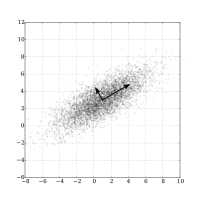
Photo from wikipedia
Magnetoencephalography (MEG) is a neuroimaging method ideally suited for non-invasive studies of brain dynamics. MEG's spatial resolution critically depends on the approach used to solve the ill-posed inverse problem in… Click to show full abstract
Magnetoencephalography (MEG) is a neuroimaging method ideally suited for non-invasive studies of brain dynamics. MEG's spatial resolution critically depends on the approach used to solve the ill-posed inverse problem in order to transform sensor signals into cortical activation maps. Over recent years non-globally optimized solutions based on the use of adaptive beamformers (BF) gained popularity. When operating in the environment with a small number of uncorrelated sources the BFs perform optimally and yield high spatial resolution. However, the BFs are known to fail when dealing with correlated sources acting like poorly tuned spatial filters with low signal-to-noise ratio (SNR) of the output timeseries and often meaningless cortical maps of power distribution. This fact poses a serious limitation on the broader use of this promising technique especially since fundamental mechanisms of brain functioning, its inherent symmetry and task-based experimental paradigms result into a great deal of correlation in the activity of cortical sources. To cope with this problem, we developed a novel data covariance modification approach that allows to build beamformers that maintain high spatial resolution when operating in the environments with correlated sources. At the core of our method is a projection operation applied to the vectorized sensor-space covariance matrix. This projection does not remove the activity of the correlated sources from the sensor-space covariance matrix but rather selectively handles their contributions to the covariance matrix and creates a sufficiently accurate approximation of an ideal data covariance that could hypothetically be observed should these sources be uncorrelated. Since the projection operation is reciprocal to the PSIICOS method developed by us earlier (Ossadtchi et al., 2018) we refer to the family of algorithms presented here as ReciPSIICOS. We assess the performance of the novel approach using realistically simulated MEG data and show its superior performance in comparison to the classical BF approaches and well established MNE as a method immune to source synchrony by design. We have also applied our approach to the MEG datasets from the two experiments involving two different auditory tasks. The analysis of experimental MEG datasets showed that beamformers from ReciPSIICOS family, but not the classical BF, discovered the expected bilateral focal sources in the primary auditory cortex and detected motor cortex activity associated with the audio-motor task. In most cases MNE managed well but as expected produced more spatially diffuse source distributions. Notably, ReciPSIICOS beamformers yielded cortical activity estimates with SNR several times higher than that obtained with the classical BF, which may indirectly indicate the severeness of the signal cancellation problem when applying classical beamformers to MEG signals generated by synchronous sources.
Journal Title: NeuroImage
Year Published: 2021
Link to full text (if available)
Share on Social Media: Sign Up to like & get
recommendations!